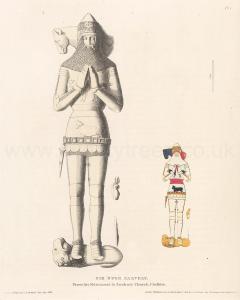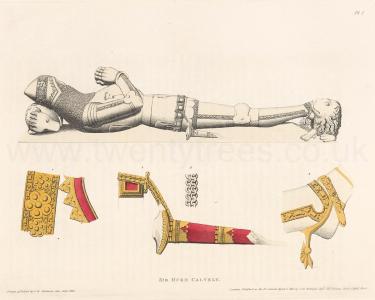Effigy of Sir Hugh Calveley
Effigy of Sir Hugh Calveley is in Monumental Effigies of Great Britain.
SIR HUGH CALVELEY, or Calverley, of Lea, in Cheshire, was a most eminent soldier in the reign of Edward the Third, and his successor Richard the Second. In 1350 we find him one of the combatants in the celebrated pitched trial of arms, or combât-à-l'outrance fought between thirty men-at-arms on the English side, and thirty on that of the Bretons, called, in allusion to the number of the champions on either party, the Battle of Trente. Sir Richard Brembre commanded the English hand, and Marshal Beaumanoir the French. Among the companions of the valiant Calveley (twenty of whom were English, the rest foreigners) were, Sir Robert Knolles, also a most distinguished knight, Croquart the Freebooter, the gigantic Hulbitee, and Thomelin de Billefort, so called from his wielding an enormous weapon of the axe kind. Sir Richard Brembre was slain fighting hand-in-hand with the famous Bertram du Guesclin; Calveley, Knolles, and Croquart, the poor remains of the English party, were taken prisoners to the Castle of Josselina.
In 1364 Calveley was in the battle of Auray, in Britanny, fought on a plain between that town and Vannes, which decided the adverse claims of John de Montfort and Charles de Blois to the Duchy of Bretagne, by the defeat and death of the latter. John Lord Chandos, who commanded the English force which supported the cause of De Montfort, assigned to Calveley the command of the reserve. Calveley's brave spirit had no relish for this post, and he exclaimed, "For God's sake, my Lord, give this charge to some other, for I desire but to fight among the foremost!" Chandos, however, explained that the success of the day depended on the reserve; and Calveley, by his firm deportment in covering and rallying the troops, when pressed by their enemy, mainly contributed to the victory.
When the Black Prince marched into Spain to support Pedro the Cruel against his bastard brother, Henry of Transtamare, Sir Hugh Calveley was with his army. He pushed forward in advance of the Prince's force, and narrowly escaped being captured by the enemy; for, having lodged for the night about a league from the English army, his attendants at sunrise were bringing him his armour, when they were suddenly attacked by a great body of Spaniards under the Conde de Sancelloni, the brother of Henry. Calveley escaped with difficulty to the vanguard of the army, commanded by the young Duke of Lancaster, John of Gaunt. This occurrence took place two days before the celebrated battle, fought between Navarete and Najara, on the banks of the Ebro, in which the Black Prince gained a complete victoryb.

Note a. Mrs. Charles Stothard (now Mrs. Bray), in her Tour through Normandy and Britanny, so replete with illustrations of English History, as connected with our wars in France, describes the very spot on which this battle occurred, a desert heath between Josselin and Ploermel, in sight of both towns. A broken cross still marks the identical place, bearing the inscription, "A la memoire perpetuelle de la Bataille de Trente, que Msr le Marechal de Beaumanoir a gaignée dans ce lieu l'an 1350." See "Letters written during a Tour through Normandy, Britanny, and other Parts of France, in 1818, including local and historical Descriptions, &c. with numerous Engravings after Drawings by Charles Stothard, F.S.A. Longman and Co. 1830. p. 216.
Note b. In the neighbourhood of Vittoria, the place where we have in our own days seen the British arms again victorious, under Wellington.
In 1377 we find Sir Hugh Captain of Calais, in which year the poet Chaucer and others were sent into France to treat of peace, but were unsuccessful. Some Englishmen, thinking there would be truce between the countries, ventured to pass the sea between Calais and Dover, but were intercepted by the galleys of the French, and slain, to the number of fifty, in sight of the garrison of Calais; at which deed Sir Hugh Calveley was highly indignant, and took an early opportunity to requite it, for he sallied out from Calais, assaulted the town and harbour of Boulogne, burnt six and twenty ships, besides smaller vessels, in the port, and great part of the lower town, and returned laden with spoil to his fortress.
He recovered about the same time the Castle of St. Marc, of which the French had got possession by the treachery of certain Picards belonging to the garrison. In 1378 Pope Urban VI. proclaimed his crusade against Pope Clement VII and his adherents; a dispute which sadly weakens the pretensions of the infallible successors of St. Peter. "As men-at-arms," says the honest Canon of Chimay, Froissart, "cannot live on pardons, and pay not much attention to them save at the point of death," he ordered a full tenth to be levied upon the goods of the church, for this military mode of proving himself orthodox, and appointed Henry Spencer, Bishop of Norwich, commander of the expedition.
Sir Hugh Calveley was one of those knights who entered into the pay of the church, and whose opinion as a veteran warrior, was constantly consulted, although not properly regarded, in the expedition. Against his advice the crusaders for Urban entered the territory of the Earl of Flanders; and, although at first they carried all before them, they were ultimately obliged to retire with precipitation, the King of France taking part with the Earl.
Froissart gives a lively description of this expedition, and of the part taken in it by Sir Hugh Calveley. The historian brings before our view the banners, pennons, and helmets of the hosts glittering in the sun; shows us Calveley on the retreat of the English, leaning on the battlements of the town of Bergues, and calculating the enemies' force by the number of their men-at-arms. "If they be but three thousand men-at-arms they are ten thousand," says Sir Hugh, alluding to the number of attendants on each lance. He found his estimate greatly exceeded when sixteen thousand lances appeared. "Let us mount our horses, and save ourselves," then exclaimed the experienced soldier. "I know no longer the state of France; I have never seen such numbers collected together by three-fourths as I now see." He directed a silent and prudent retreat in the direction of Bourbourg with the spoils they had gained. He halted in the plain to wait for his rear and baggage. Unused to retreat before the foe, this gallant soldier was overwhelmed with melancholy, and said to Sir Thomas Trivet and others who had come to meet him, "By my faith, gentlemen, we have this time made a most shameful expedition; never was so pitiful or wretched a one made from England. You would have your wills, and placed your confidence in this Bishop of Norwich, who wanted to fly before he had wings—now see the honourable end you have brought it to. There is Bourbourg; if you chose, retire thither; for my part I shall march to Gravelines and Calais, because I find we are not of sufficient strength to cope with the King of France."
Calveley returned to his garrison, the Bishop of Norwich and his adherents to Bourbourg; which they shortly after surrendered by capitulation, being allowed to retire to their own country, where they were received with disgracea. Calveley alone escaped unblamed by the general voice, as his experienced counsel had been disregarded.
Note a. Johnes's translation of Sir John Froissart's Chronicle, 8vo. edit. vol. 6. pp. 308—332.
In 1379 John de Montfort, Duke of Britanny, returned home under convoy of Sir Hugh Calveley and Sir Thomas Percy. While landing at a small port not far from St. Malo's, the ships which carried the Duke's household furniture and armour were assailed by the enemy's gallies. Sir Hugh Calveley obliged the master of the vessel in which he was, to put back, much against his will; and the archers, under the direction of Sir Hugh, hailed such a storm of arrows on the French that they were glad to retreat.
The above are some few passages of the military career of this renowned English knight. He founded in 1386, the tenth year of the reign of Richard II a college at Rome, and at Bunbury [Map] in Cheshire. A story is extant, upon no certain foundation, that he married a Queen of Arragon. He might indeed while in Spain with the Black Prince have formed an alliance with some noble lady of the Spanish court. He reposes in an altar-tomb in Bunbury church, Cheshire [Map], which bears his eRigy as represented, and is surrounded by Gothic niches, intermixed with escutcheons.
Details. Plate 1. The effigy as originally painted. On the surcoat—the coat of Calveley, Argent, a fess Gules, between three calves Sable. Crest, a calf's head Sable. On the basinet is a rich circlet or wreath. The feet rest on a golden lion. Plate H. Profile. 1. Portion of the wreath on the basinet enlarged; also ornament of the rim of the basinet, with lace of the camail. 2. Girdle, chain suspending the sword, scabbard of the sword. 3. Mails of the hauberk and camail. 4. Part of the greave, solerette, spur, and ornamented strap.

